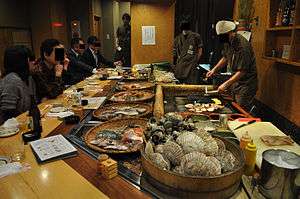Robatayaki

In Japanese cuisine, robatayaki (炉端焼き, literally "fireside-cooking"), often shortened to just robata (ろばた in hiragana), refers to a method of cooking, similar to barbecue, in which items of food on skewers are slow-grilled over hot charcoal. Many Japanese restaurants, both in Japan and abroad, specialize in this style of food preparation. Traditionally, the food consists of a combination of morsels of seafood and vegetables, but other kinds of food that are suitable for grilling may also be offered.
History
Robata originates from a centuries-old country style of cooking by northern Japanese fishermen around a communal hearth (irori) that serves both as a cooking area and a source of heat, found on the northernmost island of Japan, Hokkaido.[1] The fishermen needed a way to cook on the boats, so they encased binchotan coals in a stone box to protect the boat from the intense heat. After a government campaign depicting Hokkaido as an idyllic rustic area, this style of cooking became popular all over Japan.[1] The first robata restaurant (which was named "Robata") opened in Sendai, Miyagi Prefecture. Proving a successful formula, soon more robata restaurants followed, starting in Osaka. As of 1965, there were more than 10,000 such restaurants across the country.
In the fishermen's town of Kushiro on Hokkaido, now many restaurants specialize in this style of cuisine.[2]
The Fuki-ya restaurant once owned by Junko and Richard K. Diran in the Japan Center (San Francisco) is said to have been the first Robatayaki restaurant in the United States.[3]
Cultural connotations
While the setup varies, a common arrangement has the grill in a central position, whether as a hearth in a sand-pit as for the traditional irori, or on a raised dais, around which the customers are seated. In Japan, where the robata restaurant is often also a male-dominated drinking establishment (izakaya), this evokes a highly prized nostalgic feeling among the clientele.[4]
See also
- Teppanyaki, another style of grilling in Japanese cuisine using a hot iron surface
References
- 1 2 Justine de Lacey (March 5, 1979). "Suzuki's Method". New York. 12 (10): 108.
- ↑ Chris Rowthorn; Ray Bartlett; Justin Ellis (2005). Lonely Planet Japan (9th ed.). Lonely Planet Publications. p. 563. ISBN 978-1-74059-924-5.
- ↑ The Goldsmith (1983). "Gourmet Gemstones are the Specialty of the House".
- ↑ Michael Ashkenazi; Jeanne Jacob (2000). The Essence of Japanese Cuisine: An Essay on Food and Culture. University of Pennsylvania Press. p. 101. ISBN 0-8122-3566-5.